Captain William Kidd: end of career and posthumous glory
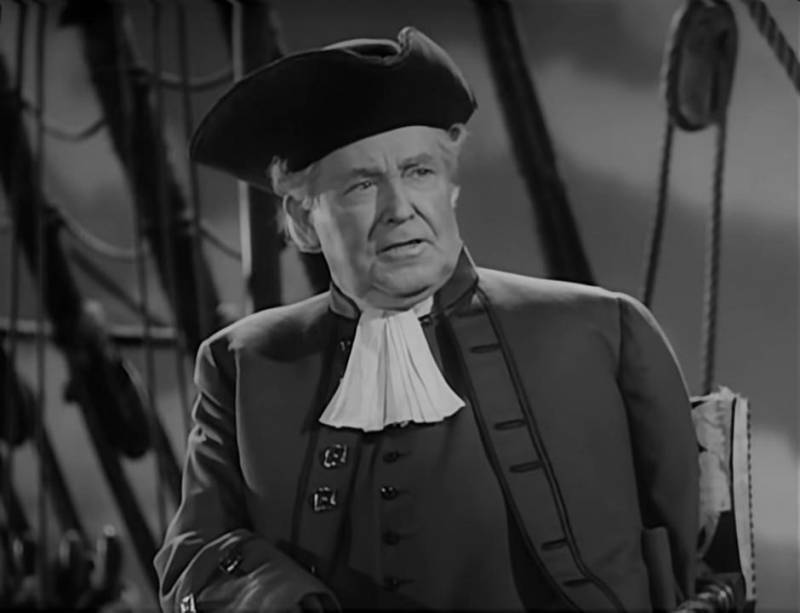
The image of the famous pirate in the American film "Captain Kidd" 1945
Kidd retained the French passes from the merchant ship Kedah Merchant, as well as the ship itself. Although the passes were at best a dubious defense against his capture, the British Admiralty and Vice Admiralty courts (especially in North America) still often turned a blind eye to privateers' overindulgence in piracy, and Kidd may have hoped that the passes would become a legal fig leaf , which will allow him to keep the captured ship and its cargo.
On April 1, 1698, Kidd reached Madagascar. Here he met the first pirate of his voyage, Robert Culliford (the same man who stole Kidd's ship many years ago), and his crew aboard the frigate Mocha.
There are two conflicting accounts of how Kidd reacted to his meeting with Culliford.
According to the "General stories Pirates,” published more than 25 years after the event, Kidd made peace proposals to Culliford: he “drank the health of their captain,” vowing that “he was in every way their brother,” and gave Culliford “an anchor and some guns.” . This account appears to be based on the testimony of Kidd's team members Joseph Palmer and Robert Bradingham at his trial.
Another version was presented by Richard Zaks in his 2002 book The Pirate Hunter: The True Story of Captain Kidd. According to Sachs, Kidd was unaware that Culliford only had about 20 crew with him, and felt that he would not be able to capture the frigate Mocha until his two prize ships arrived with their crews, so he decided not to attack until reinforcements arrived. After the expected ships appeared, Kidd ordered his crew to attack Culliford's frigate Mocha. However, his crew, despite their previous desire to seize any available prize, refused to attack Culliford and instead threatened to shoot Kidd. Zachs does not cite any sources in his version of events.
Both versions agree that most of Kidd's men have now abandoned him, siding with Culliford. There are only 13 people left on the Adventure. Deciding to return home, Kidd abandoned the Adventure, ordering it to be burned because the ship had become wormy and leaking. Before burning the ship, he was able to salvage every last piece of metal. With the faithful remnants of his crew, he returned to the Caribbean on his only remaining ship, the Prix of Adventure.
Trial and execution
Before returning to New York, Kidd learned that he was wanted as a pirate by several English warships. Realizing that the Adventure Prize was a marked vessel, he hid it and continued on to New York aboard the sloop. He hid some of his treasure on Gardiners Island, hoping to use his knowledge of its location as a bargaining tool.
Kidd ended up in Oyster Bay to avoid meeting his rebellious crew gathered in New York. To avoid them, Kidd sailed 120 miles around the eastern tip of Long Island, then returned 90 miles along the sound to Oyster Bay. He felt it was a safer passage than the busy straits between Staten Island and Brooklyn.
Investor Bellomont was away in Boston. Aware of the charges against Kidd, Bellomont was justifiably afraid of being implicated in piracy and knew that bringing Kidd to England in chains was his best chance of escape. He lured Kidd to Boston with false promises of pardon, then ordered his arrest on July 6, 1699.
Kidd was placed in Stone Prison, where he spent most of his time in solitary confinement. His wife Sarah was also jailed. The conditions of Kidd's imprisonment were extremely harsh and appear to have driven him, at least temporarily, insane. By then, Bellomont had spoken out against Kidd and the other pirates, writing that the Long Islanders were a "lawless and ungovernable people" who protected the pirates who "settled among them."
A year later, the former captain was sent to England for questioning by Parliament. The new Tory government hoped to use Kidd as a tool to discredit the Whigs who supported him, but Kidd refused to name names, naively confident that his backers would reward his loyalty by interceding on his behalf.
It is believed that he would probably have been spared if he had spoken. Finding Kidd politically useless, Tory leaders sent him to stand trial in the High Court of Admiralty in London on charges of piracy on the high seas and the murder of William Moore. While awaiting trial, Kidd was imprisoned in the notorious Newgate prison, where he wrote several letters to the king asking for clemency.
Kidd had two lawyers to assist him in his defense. He was shocked to learn in court that he had been charged with murder. He was found guilty of all charges (murder and five counts of piracy).
Former Captain Kidd was hanged on May 23, 1701 in London. During the execution, the executioner's rope broke, and Kidd was hanged on the second attempt. His body was suspended over the Thames at Tilbury Point - as a warning to future would-be pirates - for three years.
His partners Richard Barleycorn, Robert Lumley, William Jenkins, Gabriel Loffe, Able Owens and Hugh Parrott were also convicted, but were soon pardoned.
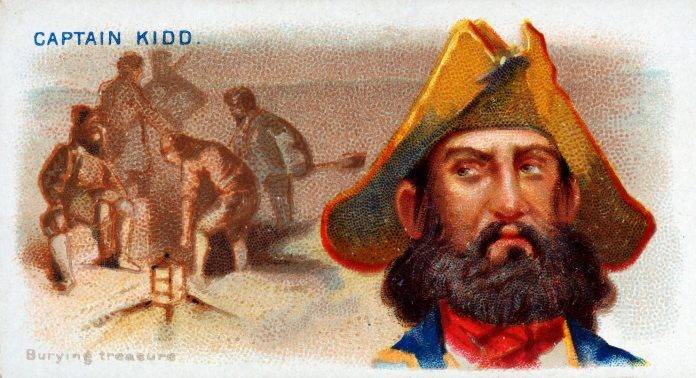
Postcard dedicated to Kidd
Kidd's Whig supporters were embarrassed by his trial. Far from rewarding his loyalty, they participated in an attempt to convict him by depriving him of money and information that might have given him some legal protection. In particular, two sets of French passes that he had were missing at the trial.
These passes (and others dating back to 1700) reappeared in the early XNUMXth century, mixed up with other government documents in the London building. These documents cast doubt on the extent of Kidd's guilt. Along with the papers, many goods were brought from the ships, which were soon sold at auction as “pirate booty.” They were never mentioned during the trial.
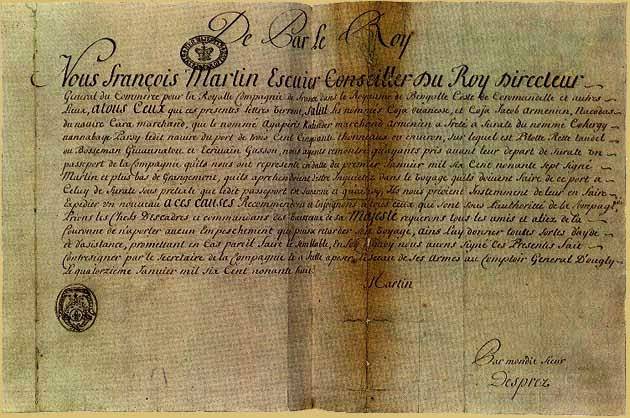
Lost during the investigation, a French passport pass that could have saved Kidd's life
As for the murder charges against Moore, they were largely refuted by the testimony of two former crew members, Palmer and Bradingham, who traded confessions against him for pardons. Information given by Palmer when he was captured in Rhode Island two years earlier supported Kidd's claims, but Kidd was unable to obtain that testimony.
The song "Captain Kidd's Farewell to the Seas, or the Lament of a Famous Pirate" was published shortly after his execution and popularized the popular belief that Kidd had confessed to the charges.
Were there any treasures?
The belief that Kidd left behind buried treasure greatly contributed to the spread of his legend. The 1701 song "Captain Kidd's Farewell to the Seas, or the Lament of the Famous Pirate" lists "Two hundred bars of gold, and many rix of dollars, which we have taken without control."
This belief contributed to literature. Edgar Allan Poe's The Gold Bug, Washington Irving's The Devil and Tom Walker, Robert Louis Stevenson's Treasure Island, and Nelson DeMille's Plum Island all mention treasures associated with Kidd.
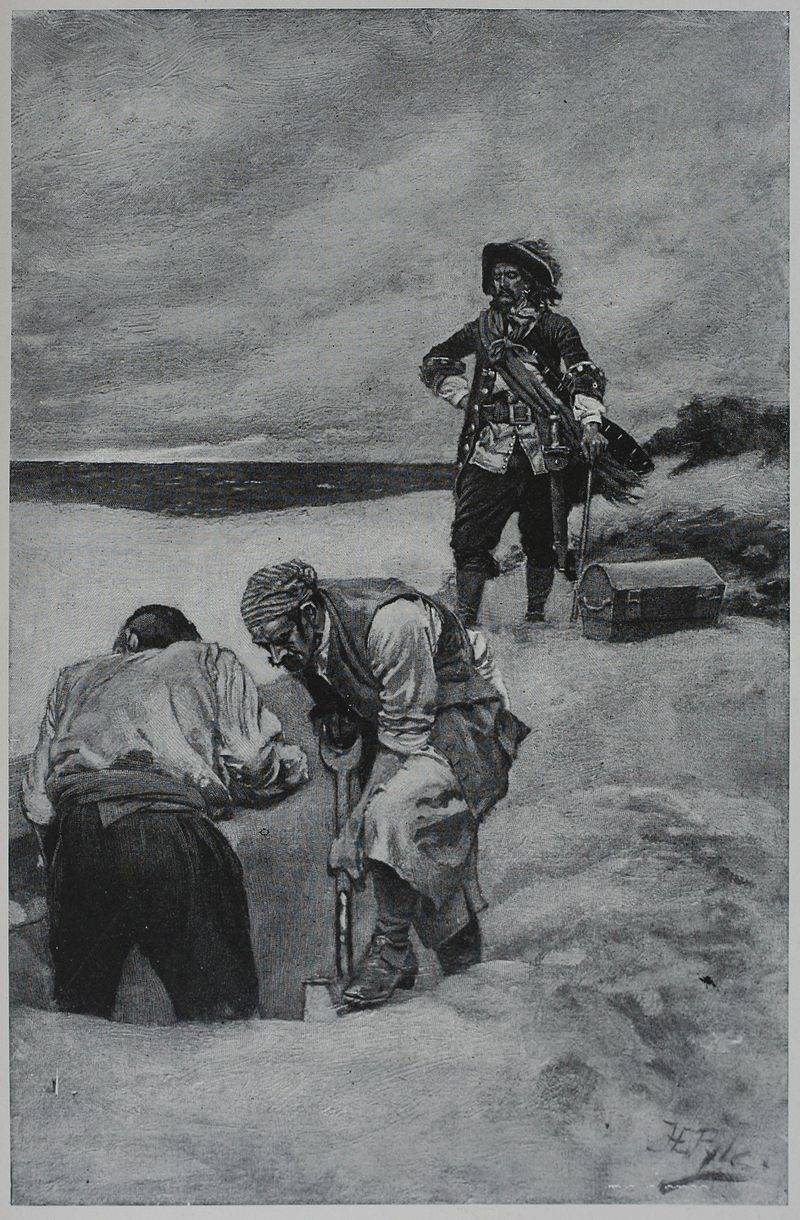
Kidd oversees the burial of treasure (illustration from Howard Pyle's Book of Pirates)
It also gave rise to ongoing treasure hunts being conducted on Oak Island in Nova Scotia; in Suffolk County on Long Island; in New York, where Gardiners Island is located; on Charles Island in Milford, Connecticut; on the Thimble Islands in Connecticut; on Kokenaw Island in Westport; and on Grand Manan Island in the Bay of Fundy.
Captain Kidd actually buried a small cache of treasure on Gardiners Island in a place known as Cherry Tree Field; however, Governor Bellomont seized it and sent it to England to use as evidence against Kidd.
Around 1699, Kidd also visited Block Island, where he stayed with Mrs. Mercy Raymond. The story goes that as a sign of gratitude for her hospitality, Mrs. Raymond was asked to hold out an apron into which Kidd threw gold and jewelry until it was full. After the death of her husband Joshua Raymond, Mercy moved with her family to northern New London, Connecticut (later Montville), where she purchased a lot of land. Thus, the Raymond family was said to have "become rich through the apron."
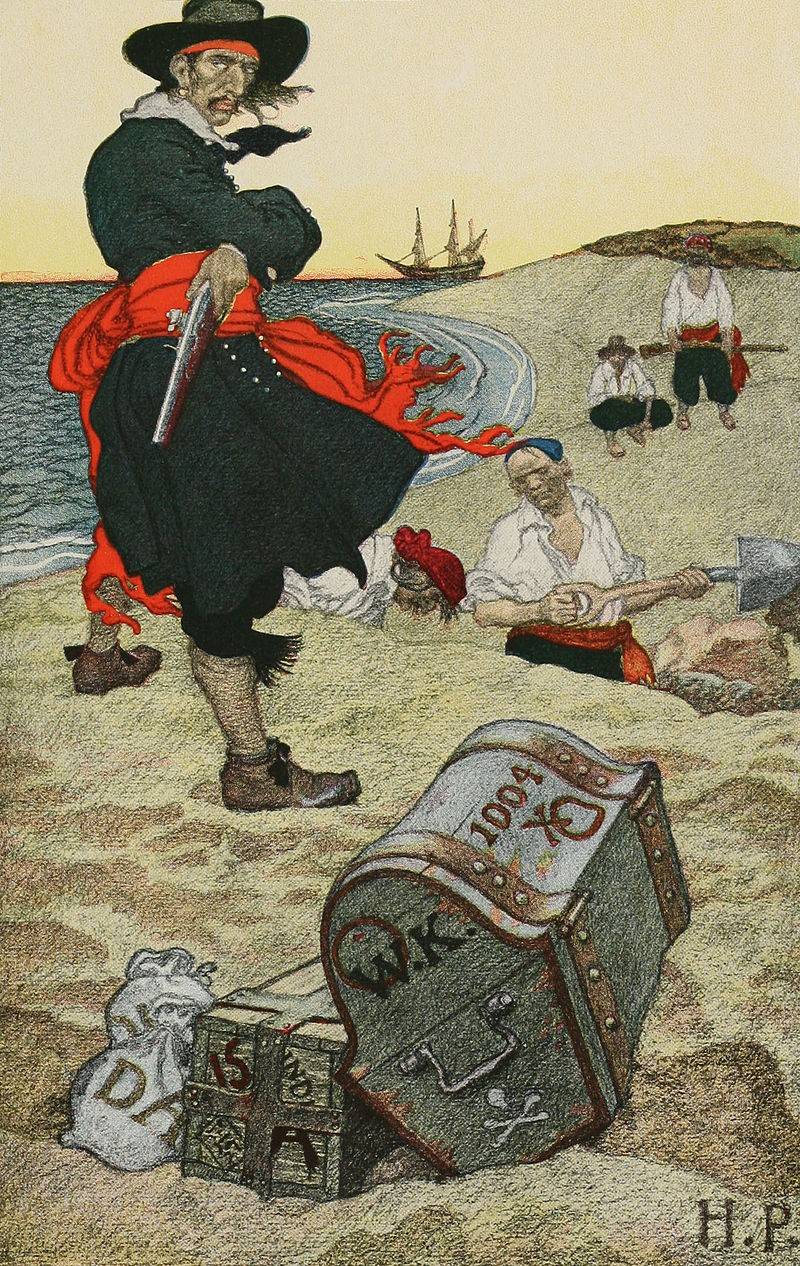
Captain Kidd controls the burial of treasure (illustration from Howard Pyle's Book of Pirates)
On the island of Grand Manan in the Bay of Fundy, as early as 1875, there was mention of a search on the west side of the island for treasure supposedly buried by Kidd during his time as a privateer. For nearly 200 years, this remote area of the island was called “Money Bay.”
In 1983, Cork Graham and Richard Knight set out in search of Captain Kidd's buried treasure off the Vietnamese island of Phu Quoc. Knight and Graham were caught, convicted of illegally landing on Vietnamese soil, and fined $10 each. They were jailed for 000 months until they paid a fine.
Finally, in 2015, off the coast of Madagascar, British divers found a silver ingot weighing 50 kg in the wreckage of a pirate ship lying at the bottom. According to experts, the ingot could have belonged to Captain Kidd.
Information